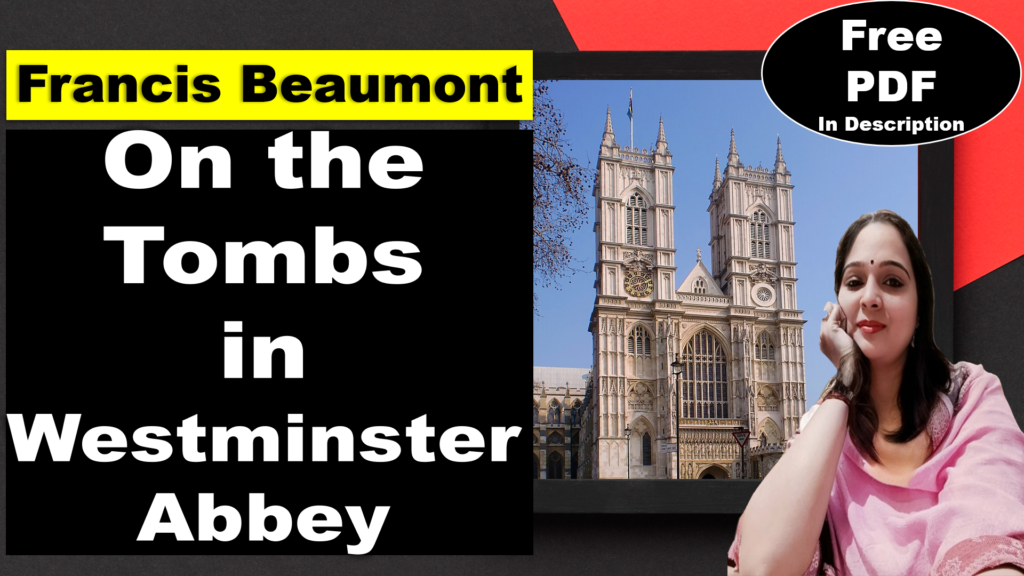
On the Tombs in Westminster Abbey Poem by Francis Beaumont | On the Tombs in Westminster Abbey | Francis Beaumont | Explanation | Summary | Key Points | Word Meaning | Questions Answers | Critical Appreciation | Free PDF Download – Easy Literary Lessons
On the Tombs in Westminster Abbey
MORTALITY, behold and fear!
What a change of flesh is here!
Think how many royal bones
Sleep within this heap of stones:
Here they lie had realms and lands,
Who now want strength to stir their hands:
Where from their pulpits seal’d with dust
They preach, ‘In greatness is no trust.’
Here ‘s an acre sown indeed
With the richest, royall’st seed
That the earth did e’er suck in
Since the first man died for sin:
Here the bones of birth have cried—
‘Though gods they were, as men they died.’
Here are sands, ignoble things,
Dropt from the ruin’d sides of kings;
Here ‘s a world of pomp and state,
Buried in dust, once dead by fate.
On the Tombs in Westminster Abbey by Francis Beaumont: YouTube Link
On the Tombs in Westminster Abbey Analysis
MORTALITY, behold and fear!
What a change of flesh is here!
Explanation
This opening line personifies Mortality, addressing it directly and urging us to confront and be afraid of its power. It also draws attention to the dramatic transformation that death inflicts on our physical bodies.
Personification: Mortality is personified as a force to be seen and feared. This makes the abstract concept of death more tangible and impactful.
Think how many royal bones
Sleep within this heap of stones:
Here they lie had realms and lands,
Who now want strength to stir their hands:
Explanation
This sentence reflects on the impermanence of power and wealth. It asks us to ponder the countless rulers who once possessed vast territories but are now reduced to mere bones under a pile of stones, unable even to move their hands.
Poetic Device
Metaphor: “Sleep within this heap of stones” is a metaphor for death, comparing the burial ground to a place of slumber.
Irony: Highlighting the contrast between the past power of those with realms and lands and their current lack of strength.
Where from their pulpits seal’d with dust
They preach, ‘In greatness is no trust.’
Explanation
This line uses the image of dusty, abandoned pulpits to represent the fallen positions of power. It suggests that even those who once preached about the unreliability of greatness have themselves become victims of its impermanence.
Poetic Device
Personification: Describing the pulpits as if they have the ability to preach, adding a human-like quality to inanimate objects.
Here ’s an acre sown indeed
With the richest, royall’st seed
That the earth did e’er suck in
Since the first man died for sin:
Explanation
This sentence employs a powerful metaphor, comparing the burial ground to an acre sown with the “richest, royall’st seed.” It emphasizes that even the most noble and influential individuals ultimately meet the same fate as everyone else and return to the earth.
Poetic Device
Metaphor: Comparing the burial ground to a cultivated acre and the buried individuals to rich and royal seeds.
Alliteration: The repetition of the ‘r’ sound in “richest” and “royall’st” creates a rhythmic flow.
Hyperbole: Calling the buried people the “richest, royall’st seed” is an exaggeration that emphasizes their former importance.
Here the bones of birth have cried—
‘Though gods they were, as men they died.’
Explanation
This line highlights the universality of death. It states that even those who were revered as gods during their lives are ultimately reduced to mere bones in death, proving their human mortality.
Poetic Device
Personification: Giving human qualities to bones, suggesting that they can cry out.
Paradox: Highlighting the contradiction that, despite being considered gods, these individuals died as mortals.
Here are sands, ignoble things,
Dropt from the ruin’d sides of kings;
Explanation
This sentence compares the once-powerful kings to insignificant grains of sand, emphasizing their complete downfall. It underscores the transient nature of power and the inevitable decay that awaits everyone.
Poetic Device
Metaphor: This sentence uses metaphor by comparing the remains of the kings to sands
Here ’s a world of pomp and state,
Buried in dust, once dead by fate.
Explanation
This final line provides a somber conclusion, summarizing the entire scene. It describes the burial ground as a once-grand world of pomp and state, now reduced to dust and forgotten by fate. It serves as a reminder of the impermanence of earthly glory and the ultimate power of death.
Poetic Device
Alliteration: alliteration with the repetition of the ‘d’ sound in “dead by dust”.





